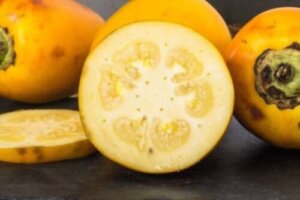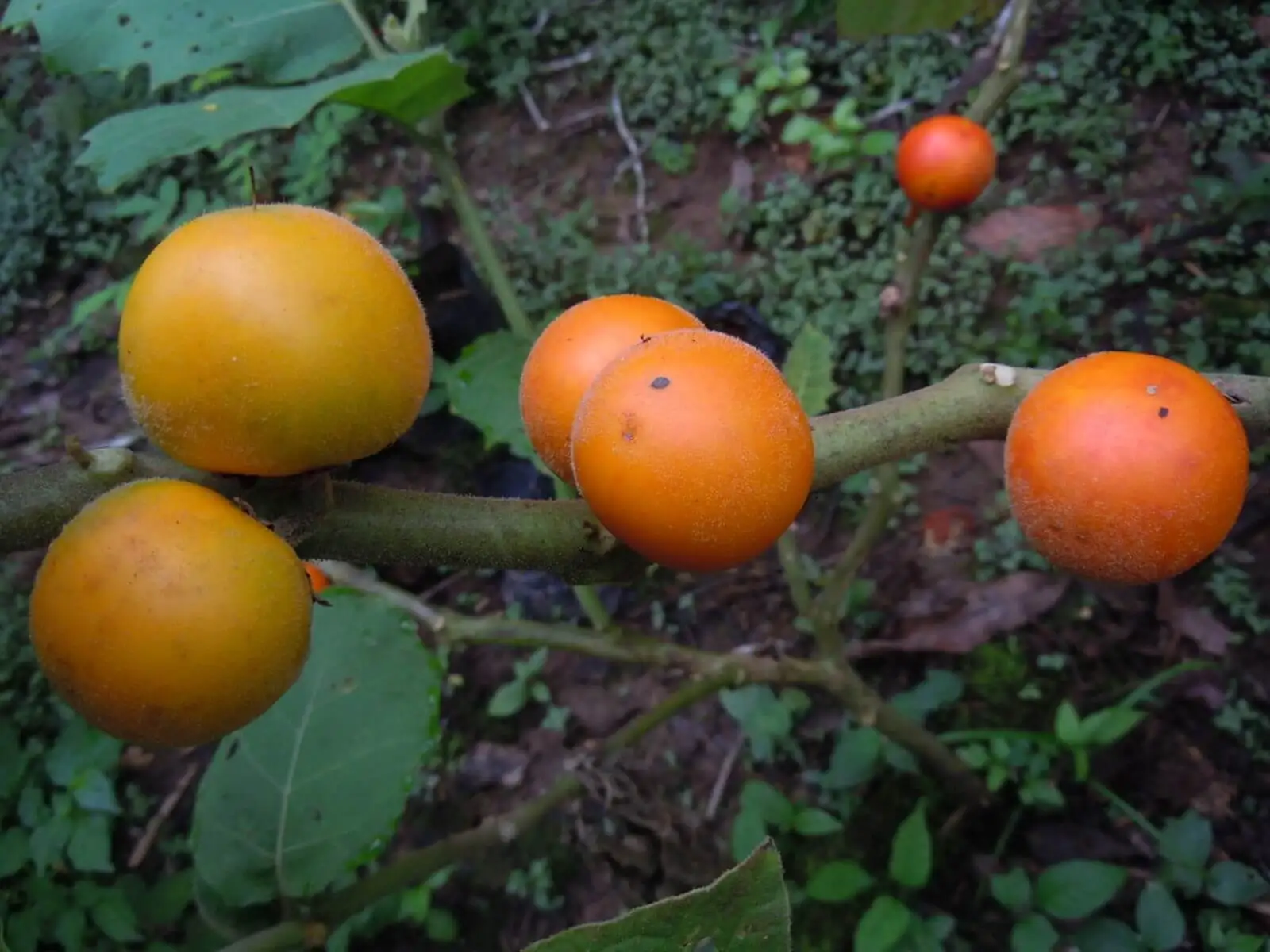What Is Cocona Oil and What Are Its Health Benefits?


Reviewed and approved by the nutritionist Maria Patricia Pinero Corredor
The cocona, scientific name Solanum sessiliflorum, is a tropical shrub native to South America, in the Andean region, which includes countries such as Peru, Ecuador and Colombia. It belongs to the Solanaceae family, which also includes tomatoes, eggplants, and potatoes.
In temperate climates, some grow it as an indoor ornamental plant; however, it’s mainly valued for the properties of its fruit, which is abundant in antioxidants, dietary fiber, vitamins, and minerals. Want to know more about it? We’ll tell you about its health benefits here.
What is cocona and what are its characteristics?
Cocona(Solanum sessiliflorum) is also known as ‘ubiu’ (Brazil), ‘tupiro’ or ‘topiro’ (Venezuela) and ‘coconilla’ or ‘lulo’ (Colombia). It’s a perennial herbaceous shrub that grows in soils of South America, especially in the Andean region and the Amazon.
The plant can reach one or two meters in height. It has pubescent stems and twigs with the same characteristic. In addition, its oval leaves are smooth on top and veined underneath; they vary in size from 25 to 45 centimeters long and 20 to 39 centimeters wide.
It has extraxillary inflorescences whose sizes vary from 3 to 10 centimeters long. Its flowers are similar to those of the potato, but are larger in size.
They have a fruit that can be almost spherical or ovoid. Its color varies between yellow, orange, and reddish. They can be 4 to 12 centimeters wide and 3 to 6 centimeters long. Also, they weigh between 24 and 250 grams.
The fruits are the most used part of the whole plant for culinary and medicinal purposes. We tell you what nutrients it provides and what it’s used for.

We think you may also like to read this article: Oolong Tea: Learn How to Prepare It and Enjoy Its Benefits
Cocona nutritional information
The fruits of the cocona are largely composed of water (up to 90%). In addition, it makes interesting contributions of carbohydrates, dietary fiber, and some essential minerals, such as calcium and iron.
In an analysis of five ecotypes of cocona – disclosed through the MDP Encyclopedia– it was estimated that each 100 grams of the fruit provides 3.12 to 4.24 grams of carbohydrates; and of fiber, between 1.8 to 1.93 grams.
As for minerals, the following values were observed:
- Potassium: between 570.83 and 2382.24 milligrams.
- Sodium: between 3.25 and 6.87 milligrams.
- Calcium: between 17.85 and 70.07 milligrams.
- Iron: between 52 and 71 milligrams.
On the other hand, a physico-chemical analysis published by the Journal of Food Composition and Analysis estimates that the protein content of cocona is 0.88 grams ( considering the pulp with seeds and peel). Lipids ranged from 0.3 to 2.23 %. The amount of fiber observed was 3.72 grams, since the amount of total fiber in the pulp and peel was evaluated.
Other nutritional values reviewed in this document were the following:
- Energy value: 29.18 kcal per 100 grams of pulp and 29.24 kcal per 100 grams of peel.
- Total carbohydrates in the pulp: 5.92 grams per 100 grams. Of these, 62.16% correspond to fiber, 37.66% to total starch, and 0.23% to sugar
- Fructose: 5.3 mg/100 g
- Sucrose: 1.4 mg/100 g
- Glucose: 7,4 mg/100 g
- Ascorbicacid (vitamin C): 19.55 mg/100 g
- β-carotene: 5.1 μg/g
- Lycopene: 31 μg/g
- Iron: 4.78 % of the daily requirement
Other essential trace elements, such as copper, chromium, and selenium, were found in the pulp, but especially in the peel. Also potassium, magnesium, and phosphorus.
A publication shared by the Food and Agriculture Organization of the United Nations (FAO) adds that cocona also contains vitamin B1 (thiamine), vitamin B2 (riboflavin) and vitamin B5 (niacin).
Cocona is a source of antioxidants
The antioxidant content of cocona should be emphasized, as these explain many of its health properties. A study shared through Frontiers in Nutrition details that this fruit is abundant in lycopene and has higher levels of beta-carotene compared to tomatoes.
Cocona health benefits
Due to its nutrient content and bioactive compounds, cocona is associated with several positive health effects. However, like other foods, its benefits are obtained when it’s included in the framework of a healthy diet. Let’s take a look.
It supports digestive health
There are no clinical studies that associate cocona consumption with digestive health. Despite this, anecdotal evidence suggests that it’s a food that improves digestion and prevents constipation. This is largely explained by its water and fiber content, two key elements for the digestive process.
Emma Slattery, a clinical dietitian at Johns Hopkins Medicineexplains that fiber increases stool volume and helps improve intestinal motility. In addition, it acts as a prebiotic, which promotes the balance of healthy bacteria in the intestine.
it helps lower cholesterol
In traditional medicine, coconut is considered a healthy supplement to lower cholesterol. In this regard, a study in mice reported in the journal Antioxidants found that the pulp of this fruit has the potential to reduce high levels of bad cholesterol (LDL) and triglycerides.
These qualities are attributed to its significant contribution of antioxidants – carotenoids, flavonoids, and coumarins, among others – which, when assimilated, help to reduce lipid oxidation.
The researchers consider that these findings open the door to the potential use of the plant in the management of diseases such as hyperlipidemia. Still, larger, human studies are needed.
It improves energy levels
Cocona has small amounts of B vitamins (niacin, thiamin, and riboflavin) that contribute to energy metabolism. As explained by a publication in the journal Nutrients, an adequate supply of these vitamins is key to the optimal functioning of the energy production system. In other words, they’re key nutrients in the process that converts food into fuel for cells.
It has anti-tumor potential
Cocone has been studied for its anti-tumor potential. In vitro research shared in Journal of Medicinal Food reported that its extracts exhibited a cytotoxic and antiproliferative effect on breast and colorectal cancer cell lines.
Bioactive compounds, such as caffeic and gallic acids, beta-carotene, catechin, quercetin, and rutin, would be behind this effect. However, this area of study is relatively new. More clinical trials are needed to corroborate the properties.
Like other foods, cocona is not a cancer treatment. It should not replace therapies prescribed by the doctor.
It helps eliminate free radicals
Cocona’s composition of carotenoids and phenolic compounds make this fruit a significant source of antioxidants. In research reported in the Journal of Agricultural and Food Chemistryextracts of this food helped eliminate all reactive oxygen species tested.
Reactive oxygen species are unstable oxygen-containing molecules that react with other molecules in the cell. Their accumulation in the body can damage DNA and cause cell death.
Other possible benefits of cocona
In folk medicine, cocona is credited with many other benefits beyond those already discussed. However, no quality studies have been conducted to corroborate such effects.
The popular literature describes other benefits, such as the following:
- Weight loss. Its consumption in the context of a healthy and varied diet can contribute to weight loss. This isn’t just due to its low-calorie intake. It’s also explained by its dietary fiber content, a compound that increases the feeling of satiety.
- Bone health. Because of its calcium content, coconut consumption is considered healthy for bones. This mineral, together with vitamin D, is key to maintaining bone density and preventing osteoporosis.
- Anemia. The nutrients in this fruit, especially iron and B-complex vitamins, help prevent anemia.
- Antibacterial potential. Cocona also appears to have potential to combat some strains of bacteria. In an in vitro study shared through the Cuban Journal of Family Medicinea 75% hydroalcoholic extract of Solanum sessiliflorum helped fight Streptococcus mutans bacteria, associated with dental disease.

Risks and contraindications of cocona
Cocona is considered safe for most people to consume. However, excessive amounts may cause diarrhea, bloating, and stomach upset.
In case of diabetes, hypertension, coagulation disorders, or any relevant chronic disease, it’s recommended to consult a doctor before regular intake of this food. Especially, if supplements derived from it are taken. This is due to the fact that its compounds may have interactions with medications used to treat such conditions.
Like this article? You may also like to read: Black Mashua: Nutritional Composition and Potential Benefits
How is cocona consumed?
One of the advantages of this fruit is that it’s very versatile and has a wide variety of culinary uses. In fact, there are those who consume the ripe fruit without further preparation, since it has an acidic flavor that resembles that of citrus fruits.
In any case, peeled and fresh it can be added to fruit salads or desserts with yogurt. It’s also ideal for preparing smoothies, juices, competes, and jams. There are those who dare a little more and add it in salads, cakes, and preparations with meat and fish.
Solanum sessiliflorum supplements can be found in capsule or powder form. These should be taken with caution and preferably under medical supervision. In addition, the consumption instructions given by the manufacturer should be followed.
What to remember about cocona
Cocona (Solanum sessiliflorum) is a plant native to South America. It’s distinguished by its characteristic fruit, which can have yellow, orange, or red hues. It’s valued for its contribution of nutrients and bioactive compounds that help promote well-being.
When included as part of a varied and healthy diet, it’s a food that provides energy, promotes digestion, helps care for cardiovascular health, and prevents the negative effects of free radicals. The best part? It’s so versatile that it can be included in many recipes, so be sure to try it!
All cited sources were thoroughly reviewed by our team to ensure their quality, reliability, currency, and validity. The bibliography of this article was considered reliable and of academic or scientific accuracy.
- Burton-Freeman, B., Liyanage, D., Rahman, S., & Edirisinghe, I. (2017). Ratios of soluble and insoluble dietary fibers on satiety and energy intake in overweight pre- and postmenopausal women. Nutrition and healthy aging, 4(2), 157–168. https://www.ncbi.nlm.nih.gov/pmc/articles/PMC5389022/
- Cáceda, H. A. V. (2023, 1 enero). Efecto antibacteriano del extracto hidroalcohólico de Solanum sessiliflorum Dunal (cocona) sobre Streptococcus mutans. Vílchez Cáceda | Revista Cubana de Medicina Militar. https://revmedmilitar.sld.cu/index.php/mil/article/view/2340/1702
- Elizalde-Romero, C. A., Montoya-Inzunza, L. A., Contreras-Angulo, L. A., Heredia, J. B., & Gutiérrez-Grijalva, E. P. (2021). Solanum Fruits: Phytochemicals, Bioaccessibility and Bioavailability, and Their Relationship With Their Health-Promoting Effects. Frontiers in nutrition, 8, 790582. https://www.ncbi.nlm.nih.gov/pmc/articles/PMC8687741/
- Foods for Constipation. (2022, 1 noviembre). Johns Hopkins Medicine. https://www.hopkinsmedicine.org/health/wellness-and-prevention/foods-for-constipation
- Hanna, M., Jaqua, E., Nguyen, V., & Clay, J. (2022). B Vitamins: Functions and Uses in Medicine. The Permanente journal, 26(2), 89–97. https://www.ncbi.nlm.nih.gov/pmc/articles/PMC9662251/
- Leal, C. G., Shamah-Levy, T., Dommarco, J. R., Villalpando, S., Haas, J., Mehta, S., & Finkelstein, J. (2020). Anemia and Iron and Vitamin B12 Deficiencies in Children Under 5 in Mexico: Results from the National Health and Nutrition Survey (ENSANUT). Current Developments in Nutrition, 4(Suppl 2), 835. https://www.ncbi.nlm.nih.gov/pmc/articles/PMC4692998/
- Marshall, K., Teo, L., Shanahan, C. W., Legette, L. L., & Mitmesser, S. H. (2020). Inadequate calcium and vitamin D intake and osteoporosis risk in older Americans living in poverty with food insecurities. PLOS ONE, 15(7), e0235042. https://journals.plos.org/plosone/article?id=10.1371/journal.pone.0235042
- Montagner, G. F. F. D. S., Barbisan, F., Ledur, P. C., Bolignon, A., Motta, J. R., Ribeiro, E. E., Praia, R. S., Azzolin, V. F., Cadoná, F. C., Machado, A. K., Barcelos, R. P., & da Cruz, I. B. M. (2020). In Vitro Biological Properties of Solanum sessiliflorum (Dunal), an Amazonian Fruit. Journal of medicinal food, 23(9), 978–987. https://pubmed.ncbi.nlm.nih.gov/32598197/
- Organización de las Naciones Unidas para la Alimentación y la Agricultura: Las bondades del túpiro: el secreto de la amazonía venezolana | FAO en Venezuela | Organización de las Naciones Unidas para la Alimentación y la Agricultura. (s. f.). https://www.fao.org/venezuela/noticias/detail-events/es/c/1460826/
- Patricio, E. B. E. (2002). Estudio fenológico de la cocona (Solanum sessiliflorum Dunal). Tegucigalpa; s.n; 2002. 31 p. tab, ilus. | LILACS | MTYCI. https://pesquisa.bvsalud.org/portal/resource/pt/biblio-877771
- Rodrigues, E., Mariutti, L. R., & Mercadante, A. Z. (2013). Carotenoids and phenolic compounds from Solanum sessiliflorum, an unexploited Amazonian fruit, and their scavenging capacities against reactive oxygen and nitrogen species. Journal of agricultural and food chemistry, 61(12), 3022–3029. https://pubmed.ncbi.nlm.nih.gov/23432472/
- Sereno, A. B., Bampi, M., Santos, I. C. D., Ferreira, S. M. R., Bertin, R. L., & Magnani, M. (2018). Mineral profile, carotenoids and composition of cocona (Solanum sessiliflorum Dunal), a wild Brazilian fruit. Journal of Food Composition and Analysis, 72, 32-38. https://www.sciencedirect.com/science/article/pii/S0889157518302941#bib0145
- Simirgiotis, M. (2022). Cocona Fruits from the Peruvian Amazon. encyclopedia.pub. https://encyclopedia.pub/entry/16053
- Slavin, J., & Carlson, J. (2014). Carbohydrates. Advances in nutrition (Bethesda, Md.), 5(6), 760–761. https://www.ncbi.nlm.nih.gov/pmc/articles/PMC4224210/
- Solanum sessiliflorum Dunal. (s. f.). https://www.gbif.org/es/species/2930435
- Tardy, A. L., Pouteau, E., Marquez, D., Yilmaz, C., & Scholey, A. (2020). Vitamins and Minerals for Energy, Fatigue and Cognition: A Narrative Review of the Biochemical and Clinical Evidence. Nutrients, 12(1), 228. https://www.ncbi.nlm.nih.gov/pmc/articles/PMC7019700/
- Vargas-Arana, G., Merino-Zegarra, C., Riquelme-Penaherrera, M., Nonato-Ramirez, L., Delgado-Wong, H., Pertino, M. W., Parra, C., & Simirgiotis, M. J. (2021). Antihyperlipidemic and Antioxidant Capacities, Nutritional Analysis and UHPLC-PDA-MS Characterization of Cocona Fruits (Solanum sessiliflorum Dunal) from the Peruvian Amazon. Antioxidants (Basel, Switzerland), 10(10), 1566. https://www.ncbi.nlm.nih.gov/pmc/articles/PMC8533405/
This text is provided for informational purposes only and does not replace consultation with a professional. If in doubt, consult your specialist.








